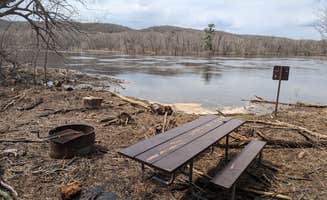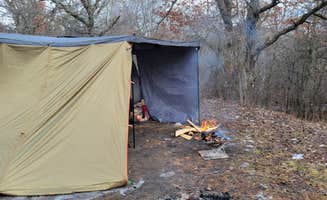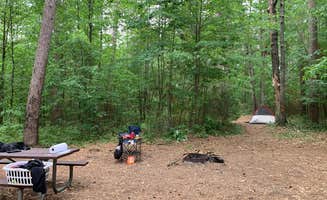Sand Dunes State Forest provides numerous dispersed camping options with terrain characterized by sandy soil, rolling hills, and a mix of pine plantations and natural hardwood stands. The forest spans 5,500 acres with elevations ranging from 900 to 970 feet above sea level. Campsites are distributed along county gravel roads with varying levels of accessibility depending on vehicle type and weather conditions.
What to do
Hiking trails: The forest features several unmarked paths between campsites that connect to longer trails. According to one camper at South of Sand Dunes State Forest, "Trails galore—horse, ski, hiking, and horseback routes all crisscross here."
Wildlife viewing: Early mornings offer opportunities to spot local wildlife. A visitor noted, "Nice quiet area. Some younger people coming through sporadically playing with their trucks but nothing serious and not often."
Water activities: For those willing to travel slightly farther, County Road O Landing provides direct river access. As one visitor mentioned, "Pretty campsite with boat ramp to St Croix river."
What campers like
Accessibility: The forest's proximity to the Twin Cities makes it popular for quick getaways. One camper at South of Sand Dunes State Forest shared, "I love that it's so close to home. I was able to walk in and find an incredible spot to camp and lay in my hammock."
Vehicle-friendly options: Many sites accommodate various vehicles. A visitor noted, "I parked near the front and closer to numbers, always like to be safer. The road goes for a long ways."
Natural experience: The ungroomed nature appeals to those seeking genuine forest camping. According to a visitor at Sandrock Cliffs, "You have to walk upstairs to get to it, but there were quite a few campsites as you walk along the hiking trail. Each one has a fire pit and a picnic table."
What you should know
Traffic patterns: Weekday evenings can bring unexpected activity. One camper reported, "Even through a Wednesday night cars are flying down the road. Almost got hit a few times walking."
Varying road conditions: Access roads change with weather and seasons. A visitor observed, "I just did an overnight camp one night in a truck camper and it was very easy to navigate and it was cleaned quiet area to spend the night. The bad part a lot of the side roads are closed to motor vehicles."
Alternative sites: For those seeking more amenities, Sandy Cove on the St. Croix River offers additional facilities. A camper noted, "There is a pad at the bottom of the path up to the open air vault toilet, a fire ring, and a table. The table has an extra long side for those in a wheelchair."
Tips for camping with families
Site selection: Choose locations farther from main roads for safety. According to one visitor, "Came back on a warm weekend. A bit more traffic, but after 12 p.m., not much of anything."
Wildlife awareness: Be prepared for wildlife encounters. A camper cautioned, "Sand storks are very protective. Stay away from them. They attack."
Insect protection: Bring appropriate repellents, particularly in summer. A visitor to County Road O Landing warned, "The spot itself was good and had restrooms. The only problem was the mosquitoes."
Tips from RVers
Size limitations: Smaller trailers and truck campers work best in most areas. A visitor advised, "Great spot. Plenty of parking. Best for straight vehicles or very small trailers."
Law enforcement interaction: Be prepared for potential questions about camping legitimacy. One RVer experienced, "I had a county sheriff person tell me it's not lawful to park a trailer and they kicked me out. I called the DNR and they said that wasn't right but I decided to leave anyway."
Pull-through options: Limited pull-through sites exist for easier parking. According to a camper, "Most spots are like the pictures shown. There are a few spots that have great views or pull-through areas, and there are limited spots that are big-rig friendly."




